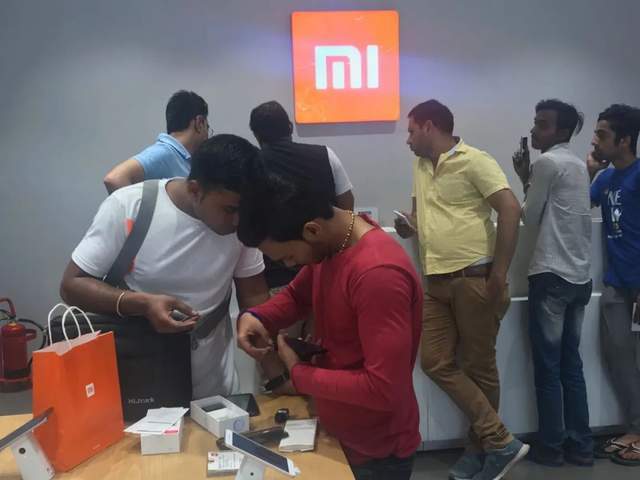The Indian Law Enforcement Bureau detained 55.51 billion rupees of Xiaomi, about RMB 4.82 billion.It is said that this is the largest seizure of the Indian authorities so far.Today, 4.8 billion yuan is still at the risk of confiscation.
According to British Reuters, the Indian Law Enforcement Bureau issued a document on June 9 that it has issued a formal notice to Xiaomi Technology India Indian Personal Co., Ltd., Xiaomi Indian Branch, some executives, and Citi, HSBC, and Germany.It is said that it is suspected of violating the Indian Foreign Exchange Management Law.
India has accused Xiaomi illegally remitting foreign entities by impersonating "franchise fees" in the local department.Xiaomi related persons responded to the media that the attitude towards the case was consistent with the previous.Previously, in response to the court's rejection of the appeal, Xiaomi said: "It is studying the matter and waiting for a written judgment. Here reiterated: in India's business, in line with relevant laws and regulations in India."
In less than a week, India made new requirements.
 Indian Law Enforcement Bureau seized the 55.51 billion rupees of Mi 55.51 billion rupees.About RMB 4.82 billion.Figure/China News Picture Network
Indian Law Enforcement Bureau seized the 55.51 billion rupees of Mi 55.51 billion rupees.About RMB 4.82 billion.Figure/China News Picture Network
According to the Indian Economic Times reported on the 13th, the Indian government demanded that China Mi, OPPO, Realme, and Vivo and other smartphone manufacturers appointed Indian people as chief executives, chief operating officers, chief financial officers and chief technical officers.
In addition, the Indian government has also instructed these companies to entrust the contract manufacturing work to Indian companies to develop manufacturing processes involved in local companies and export them through local dealers.
The report said that government officials specifically instructed Chinese companies to abide by law and not evade taxes in India.India's ABP News Network reported that Indian government officials discussed these issues with Chinese smartphone manufacturers such as Xiaomi, OPPO, Realme, and vivo at a recent meeting held by the Ministry of Electronics and Information Technology.
Where does the fine from 4.8 billion yuan come from?
Xiaomi was issued this time to go back to the "illegal remittance" disputes that began in April last year.
On April 30, 2022, local time, the Indian financial criminal strike institution said that after discovering that Xiaomi Technology India Personal Co., Ltd. remitted foreign currency to Xiaomi Group and two other foreign entities, Xiaomi Bank's account assets were confiscated.
Xiaomi Group responded quickly that night, issuing a statement saying: "These patent use fees paid by Xiaomi India are used for the authorization technology and IP of our Indian version of products.Legal business arrangements. "
Xiaomi Group also stated in the statement that as a brand dedicated to developing in India, all operations strictly abide by local laws and regulations."We carefully studied the order of government authorities. We believe that the tax and bills we paid to the bank are legal and authentic. However, we will cooperate closely with the government department to clarify any misunderstandings."
Subsequently, Xiaomi filed a lawsuit with the High Court of Karnatakn, southern India to oppose India's decision to crack down on financial criminal institutions.In August last year, at the second quarter of the 2022 Financial report analysis meeting, Wang Xiang, then president of Xiaomi Group, also said that he is actively dealing with the Indian government's investigation. All business in India is still underway, and it has successfully thawed 7More than 100 million dollars were frozen funds.
However, things reversed again quickly.In October 2022, the Indian authorities refused to thaw Xiaomi related funds.In April this year, Xiaomi India's appeal of the Indian Law Enforcement Bureau's seizure of assets was rejected by the Indian court.
As the key to argument between the two parties, "the fees for franchisees are common methods in the process of rational tax planning for multinational enterprises, and the differences mainly appear in the determination of the cost."Li Qin analyzed China News Weekly that the essence of Xiaomi's remittance dispute was tax issues. When calculating the tax base with franchise fees, the interpretation of the cost of the tax law in the tax law in the enterprise and the local government was controversial.
For example, enterprises believe that "franchise use fee" is a reasonable tax planning or normal service trade to remit funds.Overseas, related foreign exchange management laws are involved.
Indian financial criminal strike institutions have previously stated in a statement that Xiaomi Indian company remittance to other two unknown and unrelated entities, also for "the final interests of Xiaomi Group entities."
Xiaomi refutes that these patent licenses paid by Xiaomi India are for the authorization technology and patents on the Indian version of mobile phones, and more than 84%of the number of seizure of the law enforcement bureau is the franchise fee paid to Qualcomm's franchise fee fee.Essence
On June 9 this year, the Indian Law Enforcement Bureau issued a formal notice and added a statement that the reason why the bank was notified is because they were said to have approved the "franchiseForeign remittances with rights use fee ".
"At present, things have not yet settled in the dust." Li Qin analyzed that according to the Indian Foreign Exchange Management Law, if you are dissatisfied with the opinions of the administrative agency, you can continue to appeal to the foreign exchange management court and the higher court.
India has become a "foreign enterprise cemetery"?
Chinese -funded mobile phone companies that have suffered "special care" are far more than Xiaomi.
In July 2022, OPPO was accused of evading tariffs of 43.9 billion Indian rupees to about 3.8 billion yuan.According to the Indian Tax Intelligence Agency, OPPO mistakenly uses tariff exemption when importing mobile phone components, and does not include a franchise fee when calculating the value of imported goods.
In the same month, Vivo's 119 Indian -related bank accounts were blocked by the Indian Law Enforcement Bureau, with a total of 4.65 billion rupees, or about RMB 400 million.In the relevant statement, the Indian Law Enforcement Bureau accused of saying that the Vivo Indian company remitted 624.76 billion rupees (about 45.5 billion yuan) to China and other places in order to evade taxes. The amount was equivalent to about half of the company's revenue.
In the matter of strict supervision of foreign -funded enterprises, India is "equal -oriented".
In 2008, the Indian tax department issued a 7 billion rupee of "fines" to Microsoft. IBM India was also required to pay 53.57 billion rubles by the local regulatory department in 2013, equivalent to $ 866 million.According to Indian media, the Indian regulatory authorities believe that IBM lies in the revenue of fiscal year in 2009.
Samsung Electronics was punished by the Indian government more than once.In 2014, Samsung was fined $ 200 million in India.In January 2023, the Indian Tax Intelligence Bureau accused Samsung classification of errors in remote wireless electric heads, trying to avoid 17.28 billion rupees of import tariffs, about $ 212 million.
The official data released by India show that from 2014 to November 2021, 2,783 foreign companies registered in India have closed their business in India, accounting for about one -sixth of Indian multinational companies.Including the French retail giant Carrefour, American motorcycle manufacturer Harley Davidson, and Ford of the American car company.
Because foreign companies have frequently suppressed in India, India is also called "foreign enterprise cemetery".Li Qin wrote an analysis that various investigations and punishments suffered by foreign companies in India were largely due to the "magic" Indian legal system.Indian law can be summarized in fifteen words: "High standard legislation, universal illegal law, selectively enforcement."
"High standard legislation does not refer to the high legislative technology of India, but refers to the standards that Indian legislators need to meet."Nearly 30 chapters, 500, basically every one followsFunding, imprisonment and other illegal consequences, India's law enforcement agencies generally do not actively notify enterprises to correct their unsatisfactory behaviors. Once illegal acts are discovered by the administrative law enforcement department, they will start calculating fines from the first day of the violation.
In various factors, India is still considered to be one of the "most difficult countries in the world" in the global business environment report released by the World Bank in 2020.
The "Indian Market" that is difficult to give up
Even so, a large number of foreign companies, especially domestic mobile phone manufacturers, still use India as an important overseas city and make long -term layout and planning.
"The domestic smartphone market has tended to be saturated, and the product side has no revolutionary technology. It cannot stimulate new consumer demand. Domestic mobile phone manufacturers have been looking for a new market overseas." China -India Electronics Association (CMA) Secretary -General Yang Shucheng said in an interview with China News Weekly.India has a 1.4 billion population of consumer market. At that time, it was in the window period from upgrading from functional phones to smart machines.
In 2014, Xiaomi entered India.During the same period, there were brands such as vivo and OPPO. Chinese -funded mobile phone companies once occupied more than 70 % of the market share in India.
In the third quarter of 2017, Xiaomi won the Indian market share first with 9.2 million mobile phone shipments and a market share of 23.5%.Compared with the same period in 2016, Xiaomi India has increased by about 300%, becoming the fastest smartphone brand in the Indian market.At the same time, India has also become Xiaomi's largest overseas market.
However, with the "illegal remittance" dispute, Xiaomi began to "go downhill" in the Indian market.
According to Canalys data, Xiaomi (including POCO) in 2022 shipped 29.6 million units in the Indian market, down over 26%from 40.2 million units in 2021. Although it is still the sales champion of the Indian market, the whole yearThe market share has fallen to 20%, a decrease of 5 percentage points from 25%in 2021.
By the first quarter of 2023, the sales ranking in the Indian market has changed significantly.Samsung ranks first with 20%market share, Vivo ranks second with 17%market share, Xiaomi ranked third with 16%market share, and OPPO and Realme ranked behind.Chinese mobile phone brands account for about 50%of the local market.
Liu Xiaoxue, an associate researcher at the Asia -Pacific and Global Institute of Strategic Research of the Chinese Academy of Social Sciences, told China News Weekly that Chinese mobile phone manufacturers still occupy an absolute advantage in the Indian market, but India is more urgent to develop local manufacturing, and Chinese enterprises are naturalIt has become the primary goal of India's "market for technology".
Not long ago, the Indian government once again made a request to Chinese mobile phone brands including Xiaomi, OPPO, vivo, Realme, etc.: Chinese mobile phone brands operating in India should appoint Indian people as chief executives, chief operating officers, chief operating officers,Chief Financial Officer and Chief Technology Officer and other executives.
In fact, many Chinese mobile phone manufacturers operating in India have appointed Indian executives, such as Realme's Indian CEO as Indians Madhav Sheth.
"The diversity of the Indian market beyond imagination. In order to successfully enter the local market, many companies have begun to hire Indian executives before this request." Liu Xiaoxue said that from an enterprise perspective, as long as it can still be in the new market, it can still be in the new market.Profitting will continue to work.The strategy of multinational companies to open up new overseas markets will not easily change due to individual policies, and Xiaomi's experience does not mean that foreign companies will withdraw on a large scale.
However, the former chief economic adviser of the Indian government and senior researcher of Brown University Arvind Subramanian (Arvind Subramanian) published an article in diplomatic magazines last year why India could not replace China and point out that if India does not resolve "investment"The three major obstacles of risk, excessive policy introverted, and macroeconomic imbalances "may miss the investment of multinational enterprises and the opportunity to undertake industrial transfer.
Reporter: Li Mingzi



